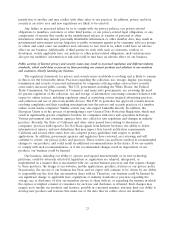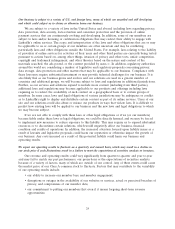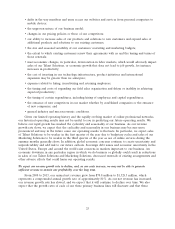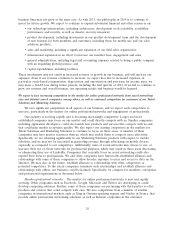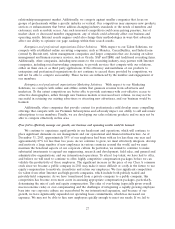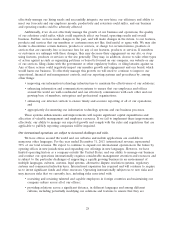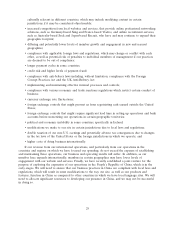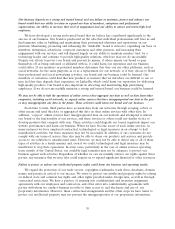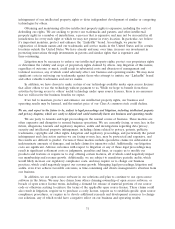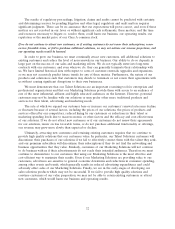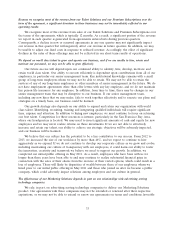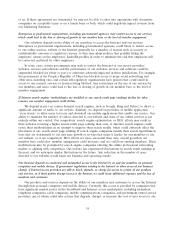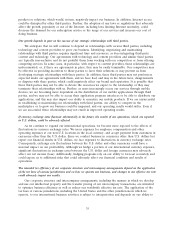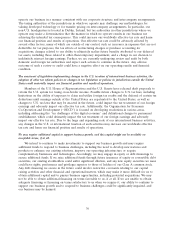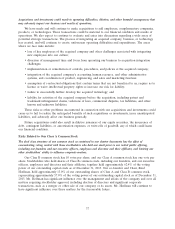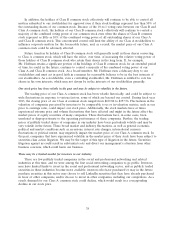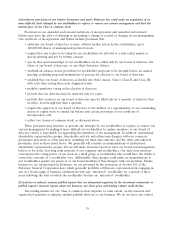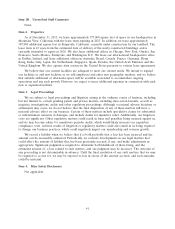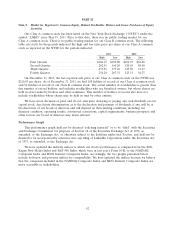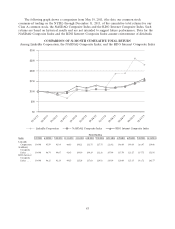LinkedIn 2013 Annual Report Download - page 35
Download and view the complete annual report
Please find page 35 of the 2013 LinkedIn annual report below. You can navigate through the pages in the report by either clicking on the pages listed below, or by using the keyword search tool below to find specific information within the annual report.Because we recognize most of the revenue from our Talent Solutions and our Premium Subscriptions over the
term of the agreement, a significant downturn in these businesses may not be immediately reflected in our
operating results.
We recognize most of the revenue from sales of our Talent Solutions and Premium Subscriptions over
the terms of the agreements, which is typically 12 months. As a result, a significant portion of the revenue
we report in each quarter is generated from agreements entered into during previous quarters.
Consequently, a decline in new or renewed agreements in any one quarter may not significantly impact
our revenue in that quarter but will negatively affect our revenue in future quarters. In addition, we may
be unable to adjust our fixed costs in response to reduced revenue. Accordingly, the effect of significant
declines in the sales of these offerings may not be reflected in our short-term results of operations.
We depend on world class talent to grow and operate our business, and if we are unable to hire, retain and
motivate our personnel, we may not be able to grow effectively.
Our future success will depend upon our continued ability to identify, hire, develop, motivate and
retain world class talent. Our ability to execute efficiently is dependent upon contributions from all of our
employees, in particular our senior management team. Key institutional knowledge remains with a small
group of long-term employees whom we may not be able to retain. We may not be able to retain the
services of any of our long-term employees or other members of senior management in the future. We do
not have employment agreements other than offer letters with any key employee, and we do not maintain
key person life insurance for any employee. In addition, from time to time, there may be changes in our
senior management team that may be disruptive to our business. If our senior management team,
including any new hires that we may make, fails to work together effectively and to execute our plans and
strategies on a timely basis, our business could be harmed.
Our growth strategy also depends on our ability to expand and retain our organization with world
class talent. Identifying, recruiting, training and integrating qualified individuals will require significant
time, expense and attention. In addition to hiring new employees, we must continue to focus on retaining
our best talent. Competition for these resources is intense, particularly in the San Francisco Bay Area,
where our headquarters is located. We may need to invest significant amounts of cash and equity for new
employees and we may never realize returns on these investments. If we are not able to effectively
increase and retain our talent, our ability to achieve our strategic objectives will be adversely impacted,
and our business will be harmed.
We believe that our culture has the potential to be a key contributor to our success. From 2012 to
2013, we increased the size of our workforce by more than 46%, and we expect to continue to hire
aggressively as we expand. If we do not continue to develop our corporate culture as we grow and evolve,
including maintaining our culture of transparency with our employees, it could harm our ability to foster
the innovation, creativity and teamwork we believe we need to support our growth. In addition, we
completed our initial public offering in May 2011. As a result, employees who have been with us for
longer than three years have been able to and may continue to realize substantial financial gains in
connection with the sales of their shares from the exercise of their vested options, which could result in a
loss of employees. There will likely be disparities of wealth between those of our employees whom we
hired prior to our initial public offering in May 2011 and those who joined us after we became a public
company, which could adversely impact relations among employees and our culture in general.
The effectiveness of our Marketing Solutions depends in part on our relationships with advertising serving
technology companies.
We rely, in part, on advertising serving technology companies to deliver our Marketing Solutions
product. Our agreements with these companies may not be extended or renewed after their respective
expirations, or we may not be able to extend or renew our agreements on terms and conditions favorable
33


